Order these records by:
Browse Collection › LC Subject Heading › 48 records found where LC Subject Heading is Business enterprises -- North Carolina -- Durham County | ||
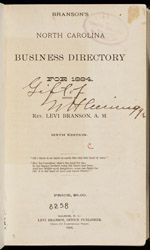 | Branson's North Carolina business guide This section of the guide contains physical attributes, land values, livestock values, taxes, and population statistics for Durham County. Branson notes that Durham County's population was 13,000, of which 8,500 were white and 4,500 were black. Also provided are the towns that had a post office, as well as county officers, court hearings, townships, magistrates, churches, pastors, and denominations. For individuals, Branson lists the name, nearest post office, and occupation. Edward James Parrish and Blackwell's Warehouse bought advertising space in the guide. | |
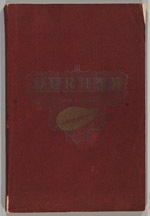 | Hand-book of Durham, North Carolina : a brief and accurate description of a prosperous and growing southern manufacturing town This pocket-sized handbook documents the people, businesses, social conditions, and government of Durham, North Carolina, and compares Durham's industrial and social advantages to other cities of the same size. It includes statistical records and information about Durham's government, health, real estate, taxes, buildings, streets, waterworks, fire departments, electric lights and gas, telephones, hotels, hospitals, markets, schools and colleges, churches, lodges, and social clubs. Included are lithographs of Mangum Street and Main Street and depictions of prominent buildings, such as: Bennett Place; Durham County Court House; the Fire House; Hotel Carolina; City Hospital; Durham Graded School; Trinity College's Main Building; Trinity Methodist Church; Main Street Methodist Church; the Presbyterian Church; the First and Second Baptist Church; bank buildings; the factory of the Blackwell Durham Tobacco Co.; Duke Tobacco Factory; and textile factories. Portraits include Isaac N. Link, ma... | |
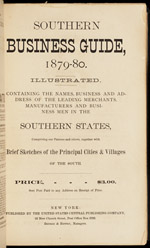 | Southern Business Guide (Excerpt) This section of the Southern Business Guide 1879-1880 contains the names of the leading merchants, manufacturers, and entrepreneurs of Durham, North Carolina. The guide lists, in alphabetical order, 54 businesses. Includes listings for businesses on Main Street as well as W. Duke, Sons and Company, Atlas Rigsbee's General Store, R. H. Wright & Company and W. T. Blackwell & Company. | |
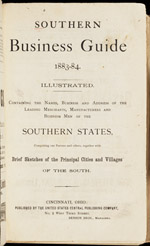 | Southern business guide, Section of the 1883-84 Southern Business Guide containing the personal names, business names, and street addresses of the leading merchants, manufacturers, and businessmen of Durham, North Carolina. Also provides a summary of Durham's history and railroad lines. The guide lists 71 businesses and their locations. | |
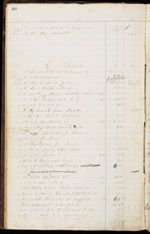 | Edward James Parrish account Atlas Rigsbee's ledger book provides insight into the nature of commerce in late nineteenth-century Durham. These pages reflect what products tobacco dealer Edward James Parrish purchased from the general store in 1880. This account provides information about the cost and availability of staple foods like eggs, meal, butter, salt, sugar, lard, and chicken, as well as luxury items like cherries and goblets. | |
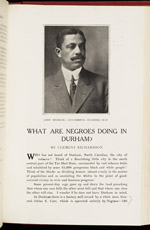 | What are Negroes doing in Durham? Essay by Clement Richardson in the Southern Workman highlighting the achievements of the African American community in Durham in the early 1910s. Richardson focuses on the contributions of black entrepreneurs and professionals including E. R. Merrick, Robert Fitzgerald, Stuart Lynn Warren, John Merrick, Dr. A. M. (Aaron McDuffie), R. H. Clegg, W. G. Pearson, J. S. Scarborough, E. W. Cannady, Dr. F. D. Page, Peyton H. Smith, P. W. Dawkins, Jr. and others. | |
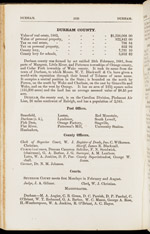 | North Carolina state directory and gazetteer, 1883-84 (Excerpt) Section of Chataigne's 1883-1884 gazetteer listing the names of merchants, business owners, and tradesmen in Durham County, categorized by occupation. The directory also provides information about public officials and the location of post offices. | |
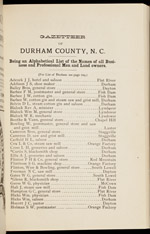 | Chas. Emerson’s North Carolina tobacco belt directory 1886 (Excerpt) This section of the 1886 directory entitled, Gazetteer of Durham County, North Carolina, lists 70 Durham County merchants and land owners, together with the name of the post office located nearest their businesses. Individuals with African American heritage are denoted by an asterisk (*). Occupations include hotel and saloon keeper, shoe maker, general store keeper and grocer, postmaster, mechanic and blacksmith, minister and pastor, saw and grist mill owner, physician, and cotton ginner. | |
 | Letter from Thomas D. Wright to Richard Harvey Wright, February 07, 1887 Thomas shares family news. Nannie Wright will take Richard's daughter, Little May to visit with Annie Snow. Little May seems "bright and playful this morning." Thomas thanks his brother for sending medicines and notes that the current illness has left him confined to his bed. Thomas asks his brother for advice on purchasing real estate from Tilley. | |
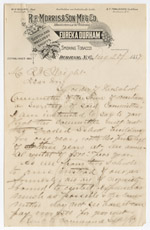 | Letter from S. F. Tomlinson to Richard Harvey Wright, August 20, 1887 In his role as secretary of the School Committee of the Town of Durham, S.F. Tomlinson writes Richard Wright about renting the "Graded School building" in Durham, North Carolina, for one year. Tomlinson requests that the contract start in September 1887 and be renewable for up to three years at $500 per year. | |
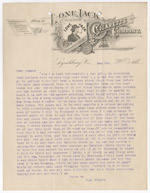 | Letter from Richard Harvey Wright to Thomas D. Wright, May 09, 1887 With anticipation of rising prices of tobacco cutters, Richard Wright advises his brother Thomas Wright to buy out Reed & McGees tobacco stock. In sharing family news, Richard writes that his daughter "Little May is I think improving." | |
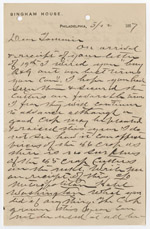 | Letter from Richard Harvey Wright to Thomas D. Wright, May 22, 1887 In this letter, Richard discusses the conditions of the tobacco crop and chastizes his brother for not heeding his previous advice to buy out "R & G on best terms you can." | |
 | Letter from Thomas D. Wright to Richard Harvey Wright, September 29, 1887 Thomas D. Wright acknowledges a letter from his brother, Richard Harvey Wright. Thomas notes that public concerns about frost damage on tobacco plants in North Carolina seem unwarranted. He believes this is the best crop of tobacco since the Civil War. He discusses real estate developments and the cost of land being sold by Tilly near Alston Avenue. Thomas closes with an update on the construction of Richard's new home. | |
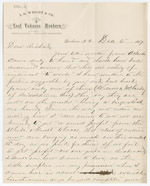 | Letter from Thomas D. Wright to Richard Harvey Wright, December 6, 1887 In this letter to his brother Richard, Thomas Wright, proprietor of the tobacco brokerage T. D. Wright and Company, shares the challenges which he faces in the tobacco market. He also notes that Mrs. Stokes lost both of her conjoined twins after their birth. | |
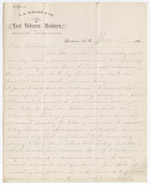 | Letter from Thomas D. Wright to Richard Harvey Wright, January 09, 1888 Thomas Wright has a gloomy outlook on his upcoming trip to Richmond in an effort to procure more tobacco. He thinks it's folly for a man to speculate in tobacco unless he has $25,000 in capital. He wants to try a different approach but needs advice and cash from his brother, Richard Harvey Wright. He asks Richard to consider helping him purchase land from Tilly. | |
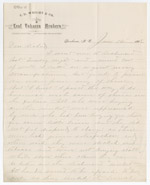 | Letter from Thomas D. Wright to Richard Harvey Wright, January 16, 1888 Thomas Wright tells his brother, Richard Harvey Wright, about his inability to sell his firm's tobacco in the Richmond market. Thomas observes that Durham-grown tobacco costs 25% more than the tobacco offered by Richmond tobacco brokers. | |
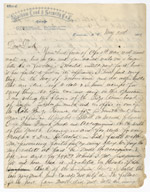 | Letter from Robert I. Rogers to Richard Harvey Wright, May 23, 1889 Robert I. Rogers, secretary of the Durham Land & Security Co. writes Richard Harvey Wright about economic news in Durham. He reports on a legal dispute over rent with "our man French." He closes by encouraging Wright to start a cotton factory. | |
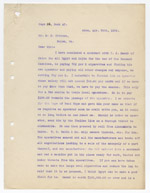 | Letter from Richard Harvey Wright to D.B. Strouse, April 19, 1889 Richard Harvey Wright sends a report to D. B. Strouse, President of the Bonsack Machine Company in which he describes his recent conversations with E. J. Manuk, a British subject and tobacco merchant living in Egypt. Wright explains the terms of the contract that will enable Manuk to use the Bonsack machine for cigarette production. | |
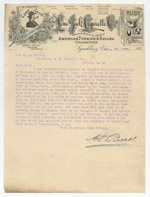 | Letter from A. T. Powell to Richard Harvey Wright, August 26, 1889 A. T. Powell, secretary and treasurer of the Lone Jack Cigarette Company in Lynchburg, Virginia sends sympathies to Richard Harvey Wright for Little May's death and confides that he also buried his first born. | |
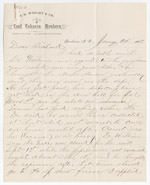 | Letter from Thomas D. Wright to Richard Harvey Wright, January 24, 1889 Thomas D. Wright updates his brother, Richard Harvey Wright, on Durham business news and the health of Mamie Richard's daughter. The child has just recovered from mumps. | |
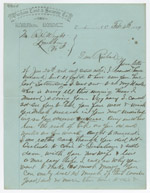 | Letter from Robert I. Rogers to Richard Harvey Wright, February 04, 1889 Robert I. Rogers, the secretary and treasurer of Durham Land and Security Company, Rogers tells Richard about real estate prices and agricultural news in Durham. | |
 | Letter from Thomas D. Wright to Richard Harvey Wright, March 20, 1889 Thomas D. Wright updates his brother, Richard Harvey Wright, Vice-President of Durham Bobbin and Shuttle Mill, on business affairs. Thomas comments that the Farmer's Alliance rented the old Reams warehouse and states that there may be a shoe factory in Durham. Eugene Morehead, a banker from Durham, died in Savannah, Georgia. | |
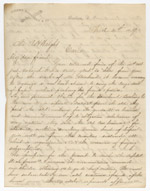 | Letter from W. M. Morgan to Richard Harvey Wright, April 04, 1889 William M. Morgan, who worked at the Eugene Morehead Bank, invites Richard Harvey Wright to join a new bank. He mentions the railroad and news about general store owner Atlas M. Rigsbee, John Markham, and tobacco dealers Stokes and Geer. | |
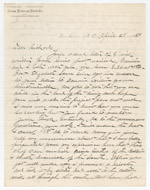 | Letter from Thomas D. Wright to Richard Harvey Wright, April 29, 1889 Thomas Wright shares a detailed report of the Durham Bobbin & Shuttle Mills's accounts and operations with his brother Richard Wright. | |
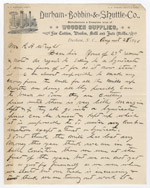 | Letter from Jacob L. Watkins to Richard Harvey Wright, August 28, 1890 Jacob Lawrence Watkins, President of Durham Bobbin and Shuttle Mill, responds to Richard Harvey Wright's letter inquiring about the selling of the company to a syndicate. Watkins believes that a trust or syndicate could benefit his business. | |
 | Letter from Thomas D. Wright to Richard Harvey Wright, July 24, 1890 Thomas Wright explains that the presents of silver have been sent to Mrs. Annie E. Snow and she is expected to forward to Mrs. Edmundson.He also discusses orders at the Durham Bobbin and Shuttle Co. | |
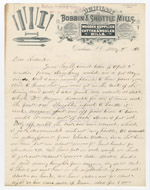 | Letter from Thomas D. Wright to Richard Harvey Wright, May 09, 1890 Thomas D. Wright acknowledges receiving Richard's letter from Hong Kong. He sends a detailed report about the fiscal situation at the Durham Bobbin and Shuttle Mill. He notes also that "Trinity College will be moved to Durham. Will locate the college, in Blackwell's Park, arrangements are now being made to commence building. Most people think Durham is on the eave of a big boom." | |
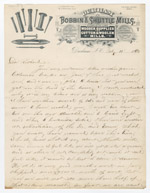 | Letter from Thomas D. Wright to Richard Harvey Wright, February 11, 1890 Thomas Wright shares tobacco market news with his brother, Richard Harvey Wright. He notes that conditions are not favorable for buying tobacco on speculation as tobacco prices are "very high." Thomas also shares his plan for buying land from "old man Tilley" to make a new home for his family. | |
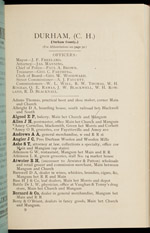 | Chas. Emerson’s North Carolina tobacco belt directory 1886 (Excerpt) This section of Emerson's 1886 directory lists businesses within the corporate limits of the town of Durham.The directory lists the names of proprietors, stores' locations and the products sold. Individuals with African American heritage are denoted by an asterisk (*). | |
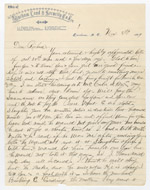 | Letter from Robert I. Rogers to Richard Harvey Wright, November 08, 1889 Robert I. Rogers shares news about real estate in Durham, the rise in tobacco prices and the upcoming meeting of Blackwell's creditors. He also comments on the smaller turn out for the evangelical preacher Sam Jones, who held his revival in Durham. | |
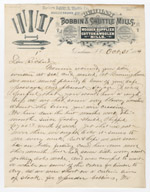 | Letter from Thomas D. Wright to Richard Harvey Wright, October 31, 1889 Thomas D. Wright shares details of the Durham Bobbin and Shuttle Mill's sales report and the condition of its 40 employees. He refers to Tom Jones's death, to religion, and to a visit from Methodist preacher Sam Jones. | |
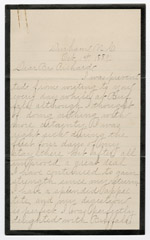 | Letter from Annie E. Snow to Richard Harvey Wright, October 01, 1889 Annie E. Snow shares family news with her brother-in-law Richard H. Wright. She also describes her meeting with the Methodist preacher Sam Jones, William T. Blackwell's bankruptcy and Julian S. Carr's travels. | |
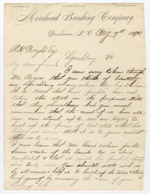 | Letter from William M. Morgan to Richard Harvey Wright, August 07, 1890 William M. Morgan expresses disappointment in Richard Harvey Wright's plans to settle in Lynchburg, Virginia, rather than Durham, North Carolina. In discussing the local economy, Morgan mentions Julian S. Carr's real estate scheme. | |
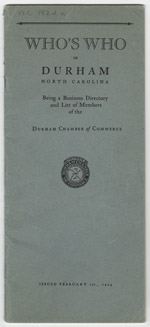 | Who's who in Durham, North Carolina ,being a business directory and list of members of the Durham Chamber of Commerce This 1924 Durham Chamber of Commerce publication contains information about the Chamber and its membership. The pamphlet provides an alphabetical listing of individual members, a classified business directory, and a section of “facts about Durham.” | |
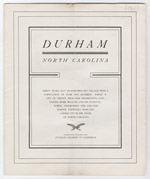 | Durham, North Carolina : thirty years ago an insignificant village with a population of some five hundred A Durham Chamber of Commerce booklet, published in 1906, which presents a short history of Durham as well as numerous photographic illustrations of educational institutions, churches, manufacturing establishments and street scenes. The pamphlet also includes statistical information about Durham County and its schools. | |
 | Gray's new map of Durham, 1881 This cadastral map from 1881 depicts buildings, street names, businesses, property owners, and railroads in Durham, North Carolina. Scale 350 feet = 1 inch or [ca. 1:4,200]. | |
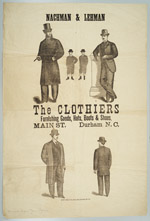 | Nachman and Lehman advertisements Poster promoting products for Nachman and Lehman, a firm that sold clothes, furnishings, hats, shoes, boots, and other goods in Durham, North Carolina. The store was located on Main Street. | |
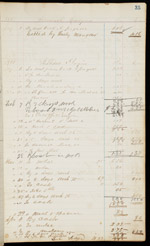 | William Hogan account These financial records indicate what products William Hogan, an African American farm laborer, purchased from the Atlas M. Rigsbee general store in 1880. This ledger account provides information about the cost and availability of staple foods like bacon, corn, and meal as well as coffee, sugar, tobacco, and ham. The account also reveals that Hogan paid for his goods with his labor. | |
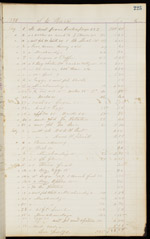 | Spencer E. Watts account These financial records indicate what products Spencer Watts, a merchant, purchased from the Atlas M. Rigsbee general store in 1880. This ledger account provides information about the cost and availability of staple foods like oil, eggs, butter, and flour as well as more costly items like chicken, fish, apples, men's clothing, parasols, and shoes. | |
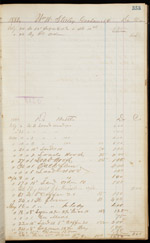 | Dr. Lee Battle account These financial records indicate what products Lee W. Battle, a physician, purchased from the Atlas M. Rigsbee general store in 1880. This ledger account provides information about the cost and availability of foods like oil, eggs, butter, lard, and flour, as well as luxury items like coffeee, rice, pepper, mace and cloves. The account indicates that Dr. Battle paid cash for his goods. | |
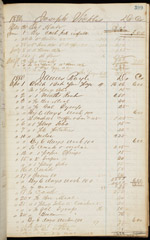 | James Rayle account These financial records indicate what products James Rayle, a machinist, purchased from the Atlas M. Rigsbee general store in 1880. This ledger account provides information about the cost and availability of coffee, lard, oil, sugar, bacon, potatoes and tobacco. The account indicates that James Rayle paid for his goods and rent with his labor. | |
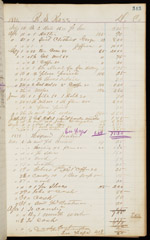 | Haywood Jenkins account These financial records indicate what products Haywood Jenkins, an African American factory hand, purchased from the Atlas M. Rigsbee general store in 1880. This ledger account provides information about the cost and availability of foods like meal, fish, lard as well as tobacco and snuff. The account indicates that Haywood Jenkins purchased goods in exchange for his labor. | |
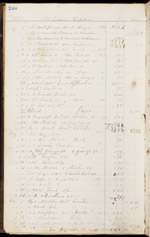 | Susan Hopkins account These financial records indicate what products Susan Hopkins, a widow and boarding-house proprietor, purchased from the Atlas M. Rigsbee general store in 1880. This ledger account provides information about the cost and availability of staple foods like oil, eggs, butter, lard, and flour as well as more costly items like chicken and ham. The account indicates that Mrs. Hopkins procured goods with cash and in exchange for boarding Rigsbee's employees. | |
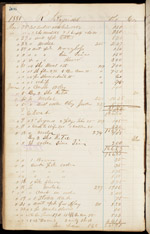 | Richard Fitzgerald account These pages from the Atlas M. Rigsbee, General Store ledger indicate what products, Richard Fitzgerald purchased from the Atlas M. Rigsbee General Store in 1880. Fitzgerald, an African American brickmaker, purchased a range of goods including foodstuffs like flour, meal, butter, sugar, and fish as well as lamp chimneys, collars and hats. The ledger indicates that Fitzgerald paid for his goods with bricks from his manufacturing enterprise. | |
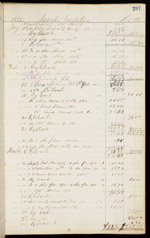 | Jacob Goldstein account These financial records indicate what products Jacob Goldstein, a, jewish immigrant and merchant, purchased from the Atlas M. Rigsbee general store in 1880. This ledger account provides information about the cost and availability of foodstuffs like bacon, meal, flour and salt. | |
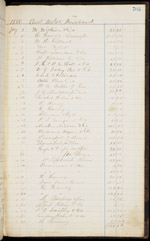 | Atlas M. Rigsbee account detailing merchandise purchased from January 5, 1880 to Sept 14,1880 These pages document the total amount of merchandise Atlas M. Rigsbee purchased from January 5, 1880 to September 14, 1880. Rigsbee procured agricultural products from North Carolina farmers. He also purchased manufactured products as well as foodstuffs from suppliers in North Carolina, Virginia, Maryland, New York, and Ohio. These pages list the names of the firms that supplied merchandise to the Atlas M. Rigsbee general store. | |
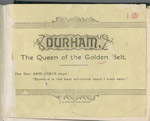 | Durham, the queen of the golden belt An pamphlet created by Durham Consolidated Land and Improvement Company to promote investment in businesses and real estate in Durham, North Carolina. Includes three lithographs of buildings in Durham: Main Building at Trinity College; West End Cotton Factory; and Wescarr Knitting Mill. Durham is described as a sophisticated town with well-developed industrial, commercial, and residential districts for: plants, mills, factories, railroad stations and tracks, banking facilities, schools, churches, and colleges. | |
 | Letter from Lucy W. Ball to Richard Harvey Wright, August 1885 Lucy attempts to console her brother Richard Harvey Wright after the death of his wife, Mamie Exum Wright. She also discusses tensions in the tobacco industry between the Duke family and her brother. | |
digitaldurham@duke.edu · About this site · Copyright © 2001 - 2006. Trudi J. Abel. All Rights Reserved.
The copyright interest in the material in this digital collection has not been transferred to the Digital Durham project. These text and images may not be used for any commercial purpose without the permission of the David M. Rubenstein Rare Book & Manuscript Library and the Digital Durham Project. Copyright permission for subsequent uses is the responsibility of the user.
